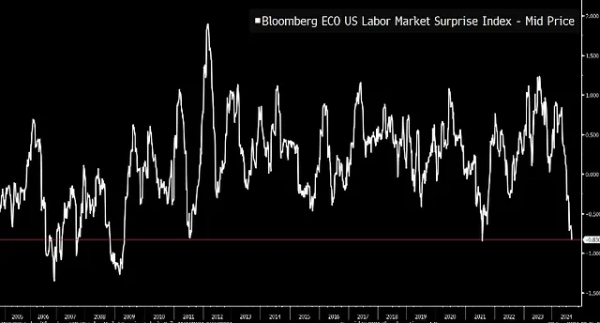Fed: the end of the tightening tunnel.
‘The time has come’ said the Federal Reserve (Fed) President Jerome Powell at the annual Jackson Hole speech on August 23rd. ‘The time has come for policy to adjust’ and ‘the direction of travel is clear’ suggesting that the Fed is preparing to cut interest rates as inflation cooled and the labour market showed signs of weakness.

This week, the Federal Reserve (Fed) will likely end the most aggressive monetary policy tightening cycle of its modern history — if we ignore the balance sheet side. The Fed is expected to continue to let up to $25 billion in Treasury securities and $35 billion in mortgage-backed securities (MBS) to mature and roll off its balance sheet every month, however without any ambition to return to pre-pandemic levels — ever again, probably.
Beyond rates and the balance sheet unwind, the Fed will also reveal its latest economic projections and update its dot plot at this week’s meeting, to give investors a hint, a roadmap regarding what to expect next.
Keep in mind that the dot plot doesn’t predict with precision what is next and the Fed members’ projections don’t bind them. On the contrary, they tend to be quite volatile.
The March dot plot had projected an average of three rate cuts of 25bp each, suggesting that rates could decrease to a midpoint of 4.6% by the end of the year. In July, the average rate cut projection fell to only one interest rate cut due to heightened inflationary pressures.
And up until last week’s CPI inflation data, the markets were pricing in a 100bp cut from the Fed this year, suggesting that the Fed would cut the interest rates at each of the remaining monetary policy meetings and will deliver one jumbo rate cut — of 50bp — in one of the meetings. Some big banks analysts continue to believe that the Fed could cut by 100bp or plus by the end of the year.
The expectation is that the Fed will start cutting the interest rates by 25bp, and not by 50bp. Even though the difference between the two is not fundamentally dramatic, the message that the Fed will send to the market by opting for one or the other would be quite decisive. A 25bp cut would mean that the Fed is done tightening its policy because inflation eased enough to let them believe that it will fall to the 2% policy target in the medium to long run, meanwhile — the cherry on top — the economic growth remained relatively strong and that there is no need — whatsoever — to hurry up because things go smoothly according to the plan.
And a slowdown in the economic growth was what the Fed wanted to achieve to cool down the inflationary pressures, in the first place. And the slowdown hasn’t been dramatic, mind you: the latest GDP number suggested that the US economy grew 3% in the Q2 and growth may have fallen to 2% this quarter — which is a level far far from a recession. So a 25bp cut would make sense.
A 50bp cut, on the other hand, is meant for financial crises, panic times, or a very severe economic meltdown, none of which are currently relevant.
Investors are increasingly worries that the Fed has ‘fallen behind the curve’ based on a few theoretical factors.
First, the famous Sahm’s rule — which suggests that the economy is already in a recession when the 3-month moving average of the unemployment rate rises by 0.50 percentage points or more above its low point over the previous 12 months. And that rule was triggered in July and suggests that the economy is already in a recession — maybe since 2–3 months already. The only time this rule wasn’t right was on Nov 1959 — and a recession arrived five month later, anyway.
And the second is, a research paper published by the Fed’s Chris Waller that argues that once the job vacancy rate falls to the pre-pandemic level of 4.6%, the unemployment rate would rise to 4.5%. And that line was crossed when the JOLTS report showed the vacancy rate declining to 4.56% in July.
As such, if we rely on economic theory, the US jobs market and the economy could be in trouble. Moreover, the labour market surprises have been quite on the negative side lately. (see Bloomberg Labor Surprise Index below).

But if we take a step back, corporate earnings have been robust, the Magnificent 7 earnings growth slowed but the remaining S&P493 have printed a positive earnings growth in the Q2 for the first time since 2022, the US GDP grew 3% and yes, the jobs market loosened but not alarmingly.
Therefore, today’s Fed decision — and the dot plot — will give the market an opportunity to readjust their expectations to a more reasonable level. The chances are that the Fed will cut the rates by 50–75pb this year (including this week’s expected cut). A potential hawkish shift in Fedexpectations could lead to a rebound in the short term yields and the US dollar, and weigh on equity valuations.
Stay ahead of the game! Catch Swissquote’s daily Market Talk for the latest market insights — click here to tune in.

Ipek Ozkardeskaya is a senior market analyst. She has begun her financial career in 2010 in the structured products desk of the Swiss Banque Cantonale Vaudoise. She worked at HSBC Private Bank in Geneva in relation to high and ultra-high net worth clients. In 2012, she started as FX Strategist at Swissquote Bank. She worked as a Senior Market Analyst in London Capital Group in London and in Shanghai. She returned to Swissquote Bank as Senior Analyst in 2020.